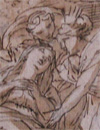|
|
|

|
 The drawings of Mariette's collection The drawings of Mariette's collection |
| |
 |
Pierre-Jean Mariette, stemming from a cultivated Parisian family, will have respite to develop his curiosity for the Arts with intelligence, method but also modesty. In a time(period) marked by the philosophy of the Lights, Mariette knew how to keep(guard), throughout her life, an ethics of matchless work: his(her,its) studious, relevant searches(researches) made of him an inescapable character of his(her,its) time(period), and its attachment for the tradition, puts into series him(it) |
"Des moeurs sages et un caractère sérieux" (Basan, Catalogue de la vente Mariette, 1775 p. III)
Lover fascinated by the Arts, him(it) not if forbid(speechless) any discipline. He(it) does not remain indifferent to an antique bronze, a sculpture or a piece of furniture of art. But gradually his(her,its) preference will go for the graphic arts, collecting drawings, paints(paintings) and engravings. " A beautiful drawing, a beautiful engraving incited its transport and a kind of enthusiasm which it inspired even to the others " (Basan, Catalog of the sale Mariette, on 1775 p. III, IV)
Pierre-Jean Mariette had inherited from a rich collection of prints, but also from drawings. During his(its) journey in Italy, he(it) forms his(its) taste. After his(its) stay in Vienna, he(it) goes to Rome by way of Venice, Bologna, Florence. The paints(paintings) of Titien, Tintoret, Véronèse, Carraches, Guerchin, compositions of Andrea del Sarto, Fra Bartolomeo and frescoes of Raphaêl and Michel-angel marked him(it) definitively and influenced his(her,its) future work. Furthermore, in each of these cities, he knew how to be bound with the scholars, the amateurs and the artists who had then the biggest reputation: we shall quote among the illustrious correspondents, Ant. Maria Zanotti in Venice, Gio. P. Zanetti in Bologna, the knight Gaburri and the scholar Bottari in Florence.
Contrary to his(her) contemporaries, his(her,its) taste is very classic. Pierre-Jean Mariette collects only little sheets(leaves) appreciated in the first part(party) of the XVIIIth century, namely the Flemish and Dutch drawings in interiors and small landscapes or the looser subjects. For him, the 'truth' drawing is the Italian drawing of the XVIth and XVIIth centuries. He buys even by correspondence this type of sheets(leaves). The influence of Pierre Crozat and its circle was certainly important. During the sale Crozat in 1741, he makes sure the most beautiful choice of drawings, and carefully, he completes his series. In 1767, Mariette admits to her correspondents that her collection of drawings is almost in the point of perfection to which he wanted to take him(it) (E. Müntz, The Archives of the Art, on 1890), and in 1769 he(it) considers all his(its) Italian drawings as one of the most complete of Europe.
Mariette does not disdain for all that her contemporaries. He(it) tries even to acquire what we can name the 'works-types' of an artist, following the example of those of his friend Edme Bouchardon, or still Rosalba Carriera. Finally, the catalog of its sale presents an attractive corpus of Scandinavian said drawings (German, Dutch and Flemish) where from the beautiful whole Albrecht Dürer stands out(goes out again).
|
 |
The collection of Pierre - Jean Mariette's drawing is not only one of the most important of his(her,its) time(weather), it is especially the reflection of a personal and safe(sure) taste which is not allowed influence by the modes(fashions) of his(her,its) time(weather) but knows how to recognize the talent. Finally she joins in the continuity of those formed by her forefathers by completing them.
This unique(only) good is scattered in public sale in 1775. |
|
 The Mariette sale The Mariette sale |
|
In his(her,its) death in 1774, the possessions of the amateur Mariette, in spite of his will to see them bequeathed to the Cabinet(Office) of King and in spite of the attempts of purchase of the royal emissaries were finally scattered in public sales.
Several documents inform us about his(her,its) collection:
- The inventory after death(deaths) of P.J. Mariette dated December 12th, 1774. This handwritten document is kept(preserved) to the national Archives (Paris. Min. LXXVI-45). We find notably the description of the present possessions in its two properties today disappeared there, the house of the street Saint Jacques in Paris and the property of Croissy.
- The catalog of the sale Mariette, engraved(burnt) by D.-F Basan in 1775. A copy of this last one is kept(preserved) in the Louvre, the cabinet(office) of Drawings. Basan notably indicates it the number of drawings " this collection generally consists besides 3400 drawings of very good order and arranged(settled) well, contained in 100 wallets(portfolioes). Closer of 6000 others both in volumes and in wallets(portfolioes)... "
- The File of the acquisitions of King in the sale of Mariette's drawings, kept(preserved) to the national Archives (Paris. O 1913, 4). This also very interesting document tells capacities(measures) taken by the Direction(Management) of the Buildings(Ships) of King in 1775 to acquire the totality of Mariette's drawings, according to the wishes of the collector. What was not able to be realized. Nevertheless, the document clarifies the drawings which were able to be acquired by King during the auction and which are at the origin of the collection(fund) Mariette of the Museum of the Louvre (today 2792 drawings).
- Finally, another very important document is a copy of the sale Mariette annotated by Gabriel de Saint Aubin.
|
 Le catalogue de la vente Mariette ilustré par Gabriel de Saint-Aubin Le catalogue de la vente Mariette ilustré par Gabriel de Saint-Aubin |
| |
 |
In the course of drafting(editorial staff)... |
|
|
© association mariette pour la promotion du dessin français - association loi 1901
|
|
|
|
